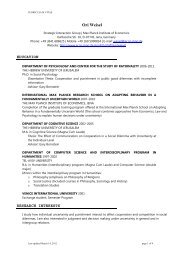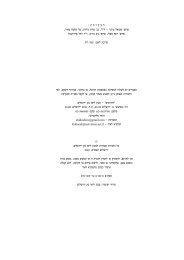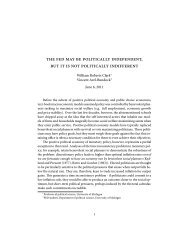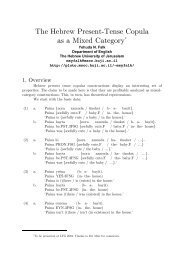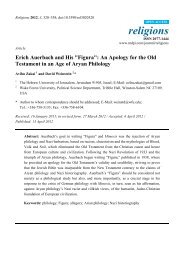Transitive verbs with non-accusative alternation in ... - Pluto Huji Ac Il
Transitive verbs with non-accusative alternation in ... - Pluto Huji Ac Il
Transitive verbs with non-accusative alternation in ... - Pluto Huji Ac Il
Create successful ePaper yourself
Turn your PDF publications into a flip-book with our unique Google optimized e-Paper software.
68<br />
Rivka Halevy<br />
‘The demonstrators called on the M<strong>in</strong>ister of Treasury to<br />
immediately beg<strong>in</strong> negotiations <strong>with</strong> the students’<br />
Like many other properties of the event, the <strong>in</strong>tention to realize the action is<br />
discourse-determ<strong>in</strong>ed, it is not just a property of one of the elements of the<br />
clause. In (10), e.g., the <strong>in</strong>tention is to realize the dream that the A had<br />
always had, and <strong>in</strong> (11), it is to negotiate immediately <strong>with</strong> the students.<br />
The English paraphrase of hitxil be- would then be ‘actually start <strong>with</strong>’ or<br />
‘start <strong>with</strong> a clear <strong>in</strong>tention to fulfill the mission’.<br />
2.2. Participant role: O<br />
2.2.1. Individuation of the O entity<br />
<strong>Ac</strong>cord<strong>in</strong>g to Hopper and Thompson’s (1980: 286) def<strong>in</strong>ition, <strong>in</strong>dividuation<br />
is “the degree to which the entity referred to by the NP is discrete, bounded<br />
and separated from its environment”. The properties of <strong>in</strong>dividuated<br />
objects, accord<strong>in</strong>g to their parameterized theory of transitivity are: proper,<br />
human/animate, concrete, s<strong>in</strong>gular, count, and referential/def<strong>in</strong>ite (Hopper<br />
and Thompson 1980: 253).<br />
In the <strong>accusative</strong> construal of the scene, the dist<strong>in</strong>ctness of O from A and<br />
its dist<strong>in</strong>ctness from its background environment are unmarked, not only <strong>in</strong><br />
terms of its <strong>in</strong>dividuality as a particular and discrete entity, but also <strong>in</strong> terms<br />
of assign<strong>in</strong>g prom<strong>in</strong>ence to it as a figure <strong>in</strong> the scene. Thus, the O is<br />
susceptible of be<strong>in</strong>g a <strong>non</strong>-<strong>in</strong>dividuated entity, as expressed, e.g. by an<br />
<strong>in</strong>def<strong>in</strong>ite noun, as <strong>in</strong> (12), or a generic noun, as <strong>in</strong> (13) and <strong>in</strong> (14), where<br />
it has a metaphorical read<strong>in</strong>g.<br />
(12) kulam lehaxziq {Ø/??be-} yadayim (class 8)<br />
everybody to-hold {Ø/??<strong>in</strong>-} hands<br />
‘Everybody hold hands’<br />
(13) ‘axbarim mexarsemim {0/??be-} bad (class 6)<br />
mice gnaw {Ø/??<strong>in</strong>-} cloth<br />
‘Mice gnaw cloth’<br />
(14) mi še-mider ‘et ha-sarim ve-qitsets lahem<br />
he-who compartmentalized OM the-m<strong>in</strong>isters and-cut-off to-them<br />
{Ø/??be-} knafayim ba-šana va-xetsi ha-'axrona<br />
(Haaretz 21.2.01) (class 4)



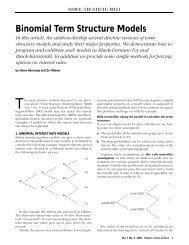
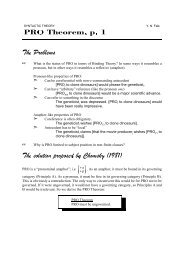
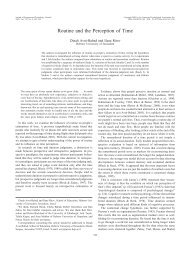
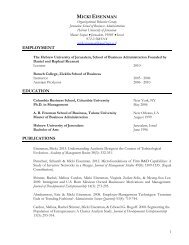
![CV [PDF] - Pluto Huji Ac Il](https://img.yumpu.com/18174585/1/190x245/cv-pdf-pluto-huji-ac-il.jpg?quality=85)

